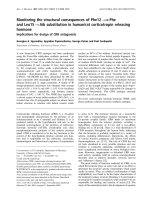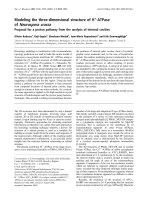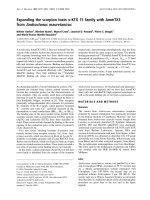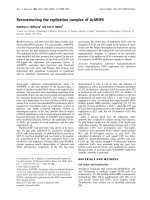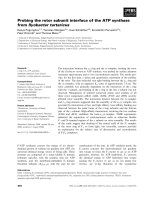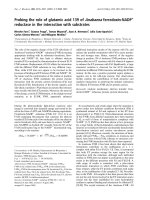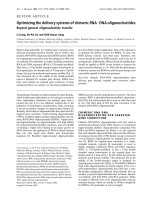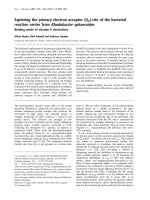Báo cáo y học: " Setting the pace: the 2011 Australasian Podiatry Council conference" pptx
Bạn đang xem bản rút gọn của tài liệu. Xem và tải ngay bản đầy đủ của tài liệu tại đây (3.58 MB, 6 trang )
JOURNAL OF FOOT
AND ANKLE RESEARCH
Setting the pace: the 2011 Australasian Podiatry
Council conference
Menz and Firth
Menz and Firth Journal of Foot and Ankle Research 2011, 4:20
(15 July 2011)
COMM E N T ARY Open Access
Setting the pace: the 2011 Australasian Podiatry
Council conference
Hylton B Menz
1*
and Julia Firth
2
Abstract
The 2011 Australasian Podiatry Council conference was held from April 26 to 29 in Melbourne, Victoria, Australia.
This commentary provides a brief overview of the conference, including the speakers and topic areas covered,
selected original research highlights, and award winning presentations.
Background
The 2011 Australasian Podiatry Council conference
(APC2011) was held at the Melbourne Exhibition and
Convention Centre from April 26 to 29, and attracted
over 1,000 delegates. The purpose of this commentary
paper is to provide an overview of the conference, includ-
ing the speakers and topic areas covered, selected original
research highlights and award winning presentations.
Speakers and topics covered
APC20 11 featured three international keynote speakers -
Professor Andrew Boulton (University of Manchester,
UK), Professor Irene Davis (Harvard University, USA) and
Dr Edward Roddy (Keele University, UK) - and 10 invited
speakers (see Table 1). The speakers attracted considerable
media attention, and interviews with Prof Irene Davis and
Trevor Prior conducted during the conference can now be
viewed at the JFAR YouTube channel [1].
In addition to the keynote and invited speaker presenta-
tions, a total of 158 free papers were submitted for consid-
eration - the largest number of submissions ever received
for an Australasian podiatry conference. A breakdown of
abstracts by topic area is shown in Figure 1, which high-
lights the dominance of research activity in the fields of
the high risk foot management and foot and ankle biome-
chanics. Of these abstracts, 54 were accepted for oral pre-
sentation and 61 for poster presentation. Each of these
abstracts can be freely downloaded as html text or as a
PDF file at the JFAR website [2]. Of particular note, the
conference program featured the largest number of
presentations of systematic reviews [3-8] and randomised
trials [9-13] indicating the increasingly high quality of
research being conducted in Australasia.
APC2011 also saw the introduction of ‘virtual’ poster
displays using flat-screen monitors, which enabled the
presentation of substantially more posters than the tra-
ditional hard copy approach. Photos from the confer-
ence are provided in Figures 2, 3, 4 and 5.
Selected original research highlights
APC2011 featured more original research papers than
any previous Australasian podiatry conference. Selected
research findings for each of the conference theme areas
are provided below.
High risk foot
• Hospital separations for diabetes-related foot dis-
ease in Victoria, Australia, vary according to the
degree of socioeconomic disadvantage of each local
government area [14]
• Standardising diabetic foot management by insti-
tuting multi-disciplinary teams, clinical pathways,
telehealth support and surveys resulted in a 64%
reduction in amputation rates and a 24% reduction
in average length of stay in Queensland hospitals
[15]
Rheumatology
• Ultrasound-guided injection of dexamethasone is
more effective than placebo (sterile saline) in the
treatment of plantar fasciitis [11]
• Intra-articular injection of hyaluronan (Synvisc
®
,
hylan G-F 20) is no more effective than placebo
(sterile saline) in the treatment of pain associated
* Correspondence:
1
Musculoskeletal Research Centre, Faculty of Health Sciences, La Trobe
University, Bundoora, Victoria, Australia
Full list of author information is available at the end of the article
Menz and Firth Journal of Foot and Ankle Research 2011, 4:20
/>JOURNAL OF FOOT
AND ANKLE RESEARCH
© 2011 Menz and Firth; licensee BioMed Central Ltd. This is an Open Access article distributed under the terms of the Creative
Commons Attribution License (http://creat ivecommons.org/licenses/by/2.0 ), which permits unrestricted use, distribution, and
reproduction in any medium, provided the original work is properly cited.
with first metatarsophalangeal joint osteoarthritis
[13]
Gerontology
• A mu ltifac eted podiatry intervention consisting of
foot orthoses, footwear advice and a foot and ankle
exercise program can reduce falls by 36% in older
people [12]
Paediatrics
• Traditional school shoes restrict children’s foot
motion during walking, particularly at the midfoot,
during the contact period and propulsion phases o f
gait [16]
• A ‘Toe-Walking Tool’ has been developed and vali-
dated as a comprehensive way to assess children
with idiopathic toe-walking and to assist in appropri-
ate referral [17]
Biomechanics and foot orthoses
• Increasing plantar sensory feedback to the medial
aspect of the foot reduces midfoot pronation during
walking [18]
• Lateral wedged insoles are no more effective than
flat inserts in the treatmen t of medial compartment
knee osteoarthritis [9]
Wound management
• A one-ye ar audit of microbiology culture results in
a high risk foot clinic indicated a surprisingly high
incidence of Methicillin-resistant Staphylococcus
aureus (16% of patients) [19]
• Negative pressure wound therapy achieves com-
plete wound closure in 60% of patients with post-
surgical wounds and is associated with a lower rate
of major amputation [20]
Surgery
• A meta- analysis of 24 studies indicates that the
scarf osteotomy produces a marginally greater
Table 1 Invited speakers
Speaker Institution
Dr Harvinder Bedi Orthosports Victoria, Melbourne
Prof Peter Brooks Australian Health Workforce Institute, Melbourne
Dr Kay Crossley University of Melbourne
Dr George Koulouris Melbourne Radiology Clinic
Dr Stephen Marty Monash University/Pharmacy Board of Australia
A/Prof Bill McGuiness La Trobe University, Melbourne
Trevor Prior Premier Podiatry, London, UK
Dr Monique Ryan Royal Children’s Hospital, Melbourne
A/Prof Jonathan
Shaw
Baker IDI Heart and Diabetes Institute,
Melbourne
Jason Warnock Podiatry Board of Australia
A/Prof Scott Wearing Bond University, Queensland
Epi
d
De
r
Pha
r
G
e
Sport
s
P
Rhe
u
Pu
b
Bio
m
Hi
g
0
Other
d
emiology
r
matology
r
macology
Education
e
rontology
s
medicine
Surgery
P
aediatrics
u
matology
b
lic health
m
echanics
g
h risk foot
0
10 20
Numbe
r
30
r
of submissi
o
o
ns
40 5
0
Figure 1 Breakdown of abstracts submitted by topic area.
Figure 2 Australasian Podiatry Council president Andrew
Schox opens the conference.
Menz and Firth Journal of Foot and Ankle Research 2011, 4:20
/>Page 2 of 5
reduction in the 1-2 intermetatarsal angle in patients
with hallux valgus compared with the chevron
osteotomy [5]
Conference award winners
The APC2011 Conference Awards Committee consisted
of Dr Karl Landorf (Chair), Dr Angela Evans, Mario
Horta and Prof Keith Rome. Four awards were pre-
sented at the conference: (i) the JFAR Best Paper Award,
(ii) the Best New Investigator Award, (iii) the Best Non-
Research Paper Award and(iv)theBest Research Poster
Award. A summary of the award-winning presentations
is provided below, and abstracts of each of the award-
winning presentations can be downloaded at the JFAR
website by following the relevant links in the reference
list.
JFAR Best Paper Award
This was awarded to Dr Shan Bergin, Southern Health,
for her presentation “Diabetes related foot disease: know
thine enemy” [14]. This paper highlighted the fact that
significant numbers of peopl e in Victoria with diabetes
suffer from neuropathy, PVD, ulcers and amputation,
and that the socio-economic status of patients’ local
are a can have a significant impact on clinical outcome s.
A full paper based on this presentation has recently
been published in JFAR [21].
Best New Investigator Award
This was awarded to Dr George Murley, La Trobe Uni-
versity, for his presentation “Do foot orthoses change
lower limb muscle activity in people with flat-arched
feet towards a pattern observed in those with normal-
arched feet?” [22]. Derived from his recently published
PhD studies, this presentation showed that the electro-
myographic (EMG) activity of lower limb muscles differs
in people with flat feet, and that foot orthoses can alter
these muscle activation patterns.
Best Non-Research Paper Award
This was awarded to Sylvia McAra, Charles Sturt Uni-
versity, for her presentation “Glyceryl trinitrate therapy
for ischaemia, painful diabetic neuropathy, healing of
foot ulceration and other podiatric conditions: a
Figure 3 Keynote speaker Professor Irene Davis.
Figure 4 Keynote speaker Dr Edward Roddy.
Menz and Firth Journal of Foot and Ankle Research 2011, 4:20
/>Page 3 of 5
literature review” [23]. Glyceryl trinitrate is widely
knowntobeaveryeffectivevasodilatorforthetreat-
ment of angina, but may also facilitate wound healing
with a mechanism of a ction similar to hyperbaric oxy-
gen therapy. This presentation provided a comprehen-
sive overview of the topical application of this therapy
for wound management.
Best Research Poster Award
This was awarded to Gordon Hendry and colleagues,
Glasgow Caledonian University, for the poster “Foot
related i mpairments and disability in juvenile idiopathic
arthritis persist despite modern day treatment para-
digms” [24]. This poster was based on a cross-sectional
survey of foot related impairments and disability in
patients with juvenile idiopathic arthritis, and showed
that approximately two thirds of the sample had mild to
moderate foot-related disability, despite being managed
with disease modif ying anti-rheumatics, anti-TNF drugs
and specialist paediatric podiatry care.
Summary
APC2011 was a highly successful event that showcased
the breadth and quality of clinical foot and ankle
research being conducted in Australasia. The next Aus-
tralasian podiatry conference will be hosted in Sydney in
2013.
Acknowledgements
Prof Hylton Menz was the Chair of the Scientific Committee and Julia Firth
was the Chair of the Organising Committee for the Australasian Podiatry
Council Conference. The authors would like the thank the Conference
Organising Committee (Peter Lazzarini, Vice Chair; Dr Sue Whicker, Treasurer;
Katrina Richards Marketing/Social Committee Chair; Chris Bishop,
Sponsorship Chair; Joel Gurr, Committee Member;
and George Wilson, Committee Member) and the Scientific Committee
(Chris Bishop, Rachael Bradhurst, A/Prof Joshua Burns, Matthew Dilnot, Dr
Angela Evans, Julia Firth, Joel Gurr, Mario Horta, Dr Karl Landorf, Dr Shannon
Munteanu, Prof Keith Rome, and Dr Sue Whicker). We would also like to
thank George Wilson for his assistance with the photographs.
Author details
1
Musculoskeletal Research Centre, Faculty of Health Sciences, La Trobe
University, Bundoora, Victoria, Australia.
2
Podiatry Department, St Vincent’s
Hospital, Melbourne, Victoria, Australia.
Authors’ contributions
HBM drafted the manuscript and JF provided feedback. Both authors read
and approved the final manuscript.
Competing interests
The authors declare that they have no competing interests.
Received: 6 July 2011 Accepted: 15 July 2011 Published: 15 July 2011
References
1. Journal of Foot and Ankle Research YouTube channel. [http://www.
youtube.com/JFootAnkleRes].
2. Proceedings of the Australasian Podiatry Council Conference 2011.
[ />3. Hawke F, Walter K, Chuter V, Burns J: Treating lower limb muscle cramps:
a Cochrane systematic review. J Foot Ankle Res 2011, 4:O17.
4. Munteanu SE, Barton CJ: Lower limb biomechanics during running in
individuals with Achilles tendinopathy: a systematic review. J Foot Ankle
Res 2011, 4:O32.
5. Smith SE, Landorf KB, Menz HB: Chevron versus scarf osteotomy for 1-2
intermetatarsal reduction in the surgical treatment of hallux valgus: a
systematic review and meta-analysis. J Foot Ankle Res 2011, 4:O44.
6. Leitch SP, Bialocerkowski AE, Warden SJ, Collins NJ, Chien AW, Crossley KM:
A systematic review and meta-analysis of conservative management of
Achilles tendinopathy. J Foot Ankle Res 2011, 4:P32.
7. McMillan AM, Landorf KB, Barrett J, Menz HB, Bird AR: Diagnostic imaging
for chronic plantar heel pain: a systematic review and meta-analysis. J
Foot Ankle Res 2011, 4:P40.
8. Zammit GV, Menz HB, Munteanu SE, Landorf KB, Gilheany MF: What is the
best available evidence for treatment of first metatarsophalangeal joint
osteoarthritis? J Foot Ankle Res 2011, 4:P61.
9. Bennell KL, Bowles K-A, Payne C, Cicuttini F, Williamson E, Forbes A,
Hanna F, Davies-Tuck M, Hinman RS: Lateral wedge shoe insoles for
medial knee osteoarthritis: a 12-month randomised controlled trial. J
Foot Ankle Res 2011, 4:O7.
10. Landorf KB, Morrow AR, Spink MJ, Nash CL, Novak A, Bird A, Potter J,
Menz HB: Effectiveness of scalpel debridement for painful plantar
calluses in older people: a randomised trial. J Foot Ankle Res 2011, 4:O23.
11. McMillan AM, Landorf KB, Gilheany MF, Bird AR, Morrow A, Menz HB:
Ultrasound guided corticosteroid injection for plantar fasciitis: a
randomised controlled trial. J Foot Ankle Res 2011, 4:O29.
12. Spink MJ, Fotoohabadi MR, Wee E, Landorf KB, Hill KD, Lord SR, Menz HB:
Efficacy of a multifaceted podiatry intervention to improve balance and
prevent falls in older people: a randomised trial. J Foot Ankle Res 2011, 4:
O47.
13. Zammit GV, Munteanu SE, Menz HB, Landorf KB, Handley CJ, ElZarka A,
DeLuca J: Intra-articular hyaluronan (Synvisc(R), hylan G-F 20) for the
treatment of first metatarsophalangeal joint osteoarthritis: a randomised,
placebo controlled trial. J Foot Ankle Res 2011, 4:O54.
14. Bergin SM, Brand CA, Colman PG, Campbell DA: Diabetes related foot
disease; ‘know thine enemy’. J Foot Ankle Res 2011, 4
:O8.
15. Lazzarini P, O’Rourke S, Russell A, Derhy P, Kamp M: Standardising
practices improves ambulatory diabetic foot management and reduces
amputations: the Queensland Diabetic Foot Innovation Project, 2006 -
2009. J Foot Ankle Res 2011, 4:O25.
16. Wegener C, Smith R, Hunt A, Vanwanseele B, Greene A, Burns J: Children’s
rearfoot and midfoot motion while walking in school shoes. J Foot Ankle
Res 2011, 4:O49.
17. Williams C, Tinley P, Curtin M: The “Toe Walking Tool": a novel method of
assessing toe walking children. J Foot Ankle Res 2011, 4:O51.
18. Bartold S, Bryant A, Clark R, Paterson K, Ritchie C: Acute effects of a shoe
with enhanced plantar sensory feedback on midfoot kinematics whilst
walking. J Foot Ankle Res 2011, 4:O2.
19. White J, Toh L, Dickson HG, Koo EN, Winters GS, Harpur MG, Widdup J,
Lau NS: Microbiology culture results in high risk foot clinic patients: an
audit. J Foot Ankle Res 2011, 4:O50.
Figure 5 The virtual poster display area.
Menz and Firth Journal of Foot and Ankle Research 2011, 4:20
/>Page 4 of 5
20. Veldhoen D, Nube V, Molyneux L: Are we doing better under pressure?
An audit of post surgical wounds managed with negative wound
pressure therapy. J Foot Ankle Res 2011, 4:O48.
21. Bergin SM, Brand CA, Colman PG, Campbell DA: The impact of socio-
economic disadvantage on rates of hospital separations for diabetes-
related foot disease in Victoria, Australia. J Foot Ankle Res 2011, 4:17.
22. Murley GS, Landorf KB, Bird AR, Menz HB: Do foot orthoses change lower
limb muscle activity in people with flat-arched feet towards a pattern
observed in those with normal-arched feet? J Foot Ankle Res 2011, 4:O33.
23. McAra S: Glyceryl trinitrate therapy for ischaemia, painful diabetic
neuropathy, healing of foot ulceration and other podiatric conditions: a
literature review. J Foot Ankle Res 2011, 4:O28.
24. Hendry GJ, Gardner-Medwin J, Watt GF, Woodburn J, McColl JH,
Sturrock RD: Foot related impairments and disability in juvenile
idiopathic arthritis persist despite modern day treatment paradigms. J
Foot Ankle Res 2011, 4:P24.
doi:10.1186/1757-1146-4-20
Cite this article as: Menz and Firth: Setting the pace: the 2011
Australasian Podiatry Council conference. Journal of Foot and Ankle
Research 2011 4:20.
Submit your next manuscript to BioMed Central
and take full advantage of:
• Convenient online submission
• Thorough peer review
• No space constraints or color figure charges
• Immediate publication on acceptance
• Inclusion in PubMed, CAS, Scopus and Google Scholar
• Research which is freely available for redistribution
Submit your manuscript at
www.biomedcentral.com/submit
Menz and Firth Journal of Foot and Ankle Research 2011, 4:20
/>Page 5 of 5


